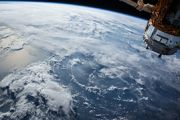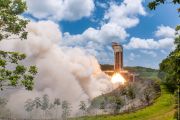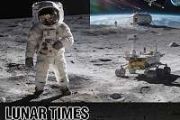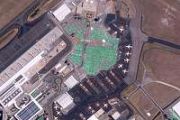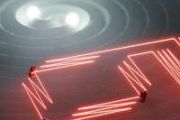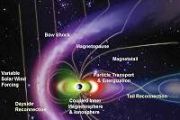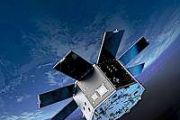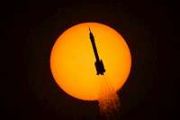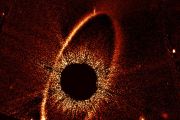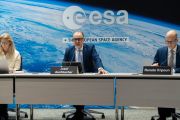
Copernical Team
First 'ghost particle' image of Milky Way galaxy captured by scientists
 From visible starlight to radio waves, the Milky Way galaxy has long been observed through the various frequencies of electromagnetic radiation it emits. Scientists have now revealed a uniquely different image of our galaxy by determining the galactic origin of thousands of neutrinos - invisible "ghost particles" which exist in great quantities but normally pass straight through Earth undetected
From visible starlight to radio waves, the Milky Way galaxy has long been observed through the various frequencies of electromagnetic radiation it emits. Scientists have now revealed a uniquely different image of our galaxy by determining the galactic origin of thousands of neutrinos - invisible "ghost particles" which exist in great quantities but normally pass straight through Earth undetected A simulation finds solutions to a central mystery in space physics
 How are plasma eruptions in near-Earth space formed? Vlasiator, a model designed at the University of Helsinki for simulating near-Earth space, demonstrated that the two central theories on the occurrence of eruptions are simultaneously valid: eruptions are explained by both magnetic reconnection and kinetic instabilities.
Rapid plasma eruptions known as plasmoids take place on the nightsi
How are plasma eruptions in near-Earth space formed? Vlasiator, a model designed at the University of Helsinki for simulating near-Earth space, demonstrated that the two central theories on the occurrence of eruptions are simultaneously valid: eruptions are explained by both magnetic reconnection and kinetic instabilities.
Rapid plasma eruptions known as plasmoids take place on the nightsi Webb detects host galaxies of quasars in the early universe
 New images from the James Webb Space Telescope have revealed, for the first time, starlight from two massive galaxies hosting actively growing black holes - quasars - seen less than a billion years after the Big Bang. A new study in Nature this week finds the black holes have masses close to a billion times that of the Sun, and the host galaxy masses are almost one hundred times larger, a ratio
New images from the James Webb Space Telescope have revealed, for the first time, starlight from two massive galaxies hosting actively growing black holes - quasars - seen less than a billion years after the Big Bang. A new study in Nature this week finds the black holes have masses close to a billion times that of the Sun, and the host galaxy masses are almost one hundred times larger, a ratio NASA's Webb identifies the earliest strands of the cosmic web
 Galaxies are not scattered randomly across the universe. They gather together not only into clusters, but into vast interconnected filamentary structures with gigantic barren voids in between. This "cosmic web" started out tenuous and became more distinct over time as gravity drew matter together.
Astronomers using NASA's James Webb Space Telescope have discovered a thread-like arrangement
Galaxies are not scattered randomly across the universe. They gather together not only into clusters, but into vast interconnected filamentary structures with gigantic barren voids in between. This "cosmic web" started out tenuous and became more distinct over time as gravity drew matter together.
Astronomers using NASA's James Webb Space Telescope have discovered a thread-like arrangement A surprise chemical find by ALMA may help detect and confirm protoplanets
 Scientists using the Atacama Large Millimeter/submillimeter Array (ALMA) to study the protoplanetary disk around a young star have discovered the most compelling chemical evidence to date of the formation of protoplanets. The discovery will provide astronomers with an alternate method for detecting and characterizing protoplanets when direct observations or imaging are not possible. The results
Scientists using the Atacama Large Millimeter/submillimeter Array (ALMA) to study the protoplanetary disk around a young star have discovered the most compelling chemical evidence to date of the formation of protoplanets. The discovery will provide astronomers with an alternate method for detecting and characterizing protoplanets when direct observations or imaging are not possible. The results Up up up and finally over: Sols 3873-3875
 We made it! We are peeking up over the edge of the ridge that we have been trying to climb for a few weeks now. The view ahead is spectacular but it's worth pausing for a minute to look back down into the canyon. You can faintly see rover tracks in the centre of the image, left behind as we slowly made our way up the hill. Lots of slipping and sliding, and drives ending too soon or terminating o
We made it! We are peeking up over the edge of the ridge that we have been trying to climb for a few weeks now. The view ahead is spectacular but it's worth pausing for a minute to look back down into the canyon. You can faintly see rover tracks in the centre of the image, left behind as we slowly made our way up the hill. Lots of slipping and sliding, and drives ending too soon or terminating o ISRO's Chandrayaan-3 Set for Mid-July Launch, Reveals ISRO Chief
 The Indian Space Research Agency (ISRO) is preparing for the anticipated launch of its third lunar expedition, dubbed Chandrayaan-3. Officials from the agency disclosed that the mission is tentatively scheduled for mid-July.
A high-ranking ISRO official mentioned, "We have the launch window between July 12 and July 19. The exact date has not been finalised."
The Chairman of ISRO and
The Indian Space Research Agency (ISRO) is preparing for the anticipated launch of its third lunar expedition, dubbed Chandrayaan-3. Officials from the agency disclosed that the mission is tentatively scheduled for mid-July.
A high-ranking ISRO official mentioned, "We have the launch window between July 12 and July 19. The exact date has not been finalised."
The Chairman of ISRO and Gullies on Mars could have been formed by recent periods of liquid meltwater
 A study led by Brown University researchers offers new insights into how water from melting ice could have played a recent role in the formation of ravine-like channels that cut down the sides of impact craters on Mars.
The study, published in Science, focuses on Martian gullies, which look eerily similar to gullies that form on Earth in the Dry Valleys of Antarctica and are caused by wate
A study led by Brown University researchers offers new insights into how water from melting ice could have played a recent role in the formation of ravine-like channels that cut down the sides of impact craters on Mars.
The study, published in Science, focuses on Martian gullies, which look eerily similar to gullies that form on Earth in the Dry Valleys of Antarctica and are caused by wate Long history and bright future of space sample deliveries
 When NASA's OSIRIS-REx spacecraft releases a capsule with material from asteroid Bennu onto the Utah desert on Sept. 24, it will become the latest in a line of missions to gather samples from space and deliver them to Earth. Collecting material from space is a challenging feat that requires teams of dedicated scientists and engineers, innovative technology, and patience. But the scientific break
When NASA's OSIRIS-REx spacecraft releases a capsule with material from asteroid Bennu onto the Utah desert on Sept. 24, it will become the latest in a line of missions to gather samples from space and deliver them to Earth. Collecting material from space is a challenging feat that requires teams of dedicated scientists and engineers, innovative technology, and patience. But the scientific break SpaceX Dragon begins return to Earth with experiments, samples from ISS
 A SpaceX Dragon cargo spacecraft left the International Space Station on Thursday to return to Earth with NASA experiments and samples dating back as far as six years.
The spacecraft left the ISS's Harmony module at 12:30 p.m. EDT and is set to make a parachute-assisted splashdown off the coast of Florida at about 10:30 a.m. on Friday.
The spacecraft is carrying more than 3,600 p
A SpaceX Dragon cargo spacecraft left the International Space Station on Thursday to return to Earth with NASA experiments and samples dating back as far as six years.
The spacecraft left the ISS's Harmony module at 12:30 p.m. EDT and is set to make a parachute-assisted splashdown off the coast of Florida at about 10:30 a.m. on Friday.
The spacecraft is carrying more than 3,600 p 








